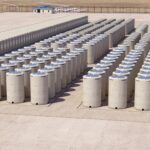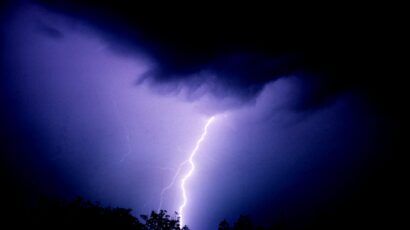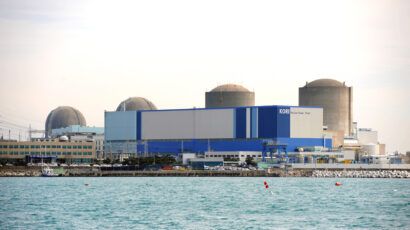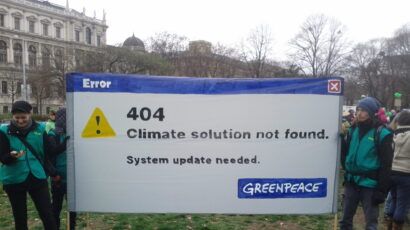Shale: an overlooked option for US nuclear waste disposal
By Chris Neuzil | November 27, 2014

Toss a dart at a map of the United States and, more often than not, it will land where shale can be found underground. A drab, relatively featureless sedimentary rock that historically attracted little interest, shale (as used here, the term includes clay and a range of clay-rich rocks) is entering Americans’ consciousness as a new source of gas and oil. But shale may also offer something entirely different—the ability to safely and permanently house high-level nuclear waste.
More than 70,000 metric tons of commercial spent nuclear fuel currently sit aboveground at 75 power-generation facilities across the United States. Surface storage of this growing inventory of long-lived waste is both a financial and security burden, and as the 2011 tsunami at Fukushima graphically showed, threats can be hard to anticipate. Recognizing this, plans in the United States and other nuclear nations, however vague, call for the eventual isolation of high-level waste underground. The devil is in the details of where and how to accomplish this.
Because spent nuclear fuel remains dangerous for hundreds of thousands of years, it is helpful (and arguably necessary) for the rock housing an underground repository to provide long-term containment as a backup to the waste packaging and repository engineering itself. Globally, considerable research is being devoted to determining what types of rock can do this. Sweden and Finland are almost entirely underlain by granite and well along with plans for granite-hosted repositories. Germany, once focused on underground salt formations, is considering its options. France, Switzerland, and Belgium are planning or considering repositories in shale.
The United States, under the Nuclear Waste Policy Act of 1982, studied granite, salt, basalt (a rock formed by volcanic lava), and tuff (a rock made of volcanic ash) until the Act was amended in 1987 to focus exclusively on the tuff at Yucca Mountainin Nevada. Shale has never even had a cameo appearance in the US waste program. Yet the picture emerging from studies in Europe and elsewhere is that shale has unique attributes as a host rock.
Regulators want to know what will happen to high-level waste in a repository for hundreds of thousands, or even a million, years after it is put there. Predicting the waste’s fate is much more difficult than anyone originally imagined, in large part because of water. Rock underground is permeated by groundwater, which has the potential to dissolve waste and carry it beyond the repository. How quickly this can happen depends on how easily fluid flows through rock pores, a property called permeability.
Incredible as it may seem, permeability in rocks underground can vary by a factor of 100 million billion. That is roughly the difference between the thickness of a human hair and the width of the solar system. Granite, salt, and shale are near the low end of the range, meaning they are something like 1,000 times less permeable than cement grout. Permeability this low implies that only negligible movement of waste-carrying groundwater is possible even after hundreds of thousands of years. In theory, any of these rock types should ensure containment of nuclear waste.
As you might guess, though, things are not so simple. Permeability in bodies of rock big enough for a repository—say, a square kilometer or more in area—typically varies in ways that defy prediction. This can arise from mixed rock types with different permeabilities, but naturally occurring fractures are the biggest culprit. Fractures are groundwater superhighways that can increase permeability—and potentially decrease travel time for waste—by a factor of 100 million or more. Drilling is the best way to identify fractures and other permeability variations, but a potential repository site punctured by numerous boreholes is not something you want.
Shale formations exhibit a peculiarity that suggests a way around this problem and, at the same time, shows that many of them are almost completely isolated from their surroundings. Of shale sites carefully studied to date, about half have been found to have groundwater pressure conspicuously higher or lower than expected. These pressure “anomalies” are hard to explain unless they are caused by geological disturbance so gradual it is hard to detect, such as rock expanding after melting of a heavy glacial ice sheet or being squeezed by mountain-building tectonic forces. Much like a proper inflation reading for a car tire, a pressure anomaly signals that almost no groundwater is able to leak from the shale. What’s more, pressure anomalies show that conditions have prevailed for tens to hundreds of thousands of years, because they take that long to form. This is a persuasive argument that conditions can also be predicted far into the future.
So there is reason to believe shale can isolate spent nuclear fuel underground as long as needed. Shale also has what amounts to built-in containment redundancies, including a tendency for clay particles to sorb, or grab, dissolved waste. Then there is the sheer abundance of shale, which greatly expands geographic options for repository siting, even when oil- and gas-rich or otherwise unsuitable formations are ruled out.
On the flip side, concerns about shale include the possible instability of excavated repository shafts and rooms, and permeability increases caused by excavation. Shale is also a poor conductor of heat, which means a shale-based repository could get hotter than a facility sited in a different type of rock.
Shale’s virtues and deficits should be evaluated in the context of what has been learned about other rock types. Salt has extremely low permeability and is so deformable that fractures quickly heal, and even repository access shafts would close over time. But salt is wetter than first supposed, and heat from spent nuclear fuel may draw corrosive brine into a repository. (The salt-hosted Waste Isolation Pilot Plant facility in New Mexico, which until a recent incident was the world’s only operating geologic repository for long-lived radioactive wastes, accepts only transuranic wastes producing little heat.) Tuff at Yucca Mountain is above the water table and in a location where rainfall is scant. Nevertheless, there is evidence that water may pass through the tuff relatively quickly, perhaps along fractures. Excavations in granite are quite stable, and granite handles heat from spent fuel with little difficulty, but groundwater flow is affected by fractures and difficult to predict.
Shale is the only rock type likely to house high-level nuclear waste in other countries that has never been seriously considered by the US high-level waste program. The uncertain future of Yucca Mountain places plans for spent nuclear fuel in the United States at a crossroads. It is an opportunity to include shale in a truly comprehensive examination of disposal options.
Together, we make the world safer.
The Bulletin elevates expert voices above the noise. But as an independent nonprofit organization, our operations depend on the support of readers like you. Help us continue to deliver quality journalism that holds leaders accountable. Your support of our work at any level is important. In return, we promise our coverage will be understandable, influential, vigilant, solution-oriented, and fair-minded. Together we can make a difference.
Topics: Analysis, Nuclear Energy, Technology and Security















